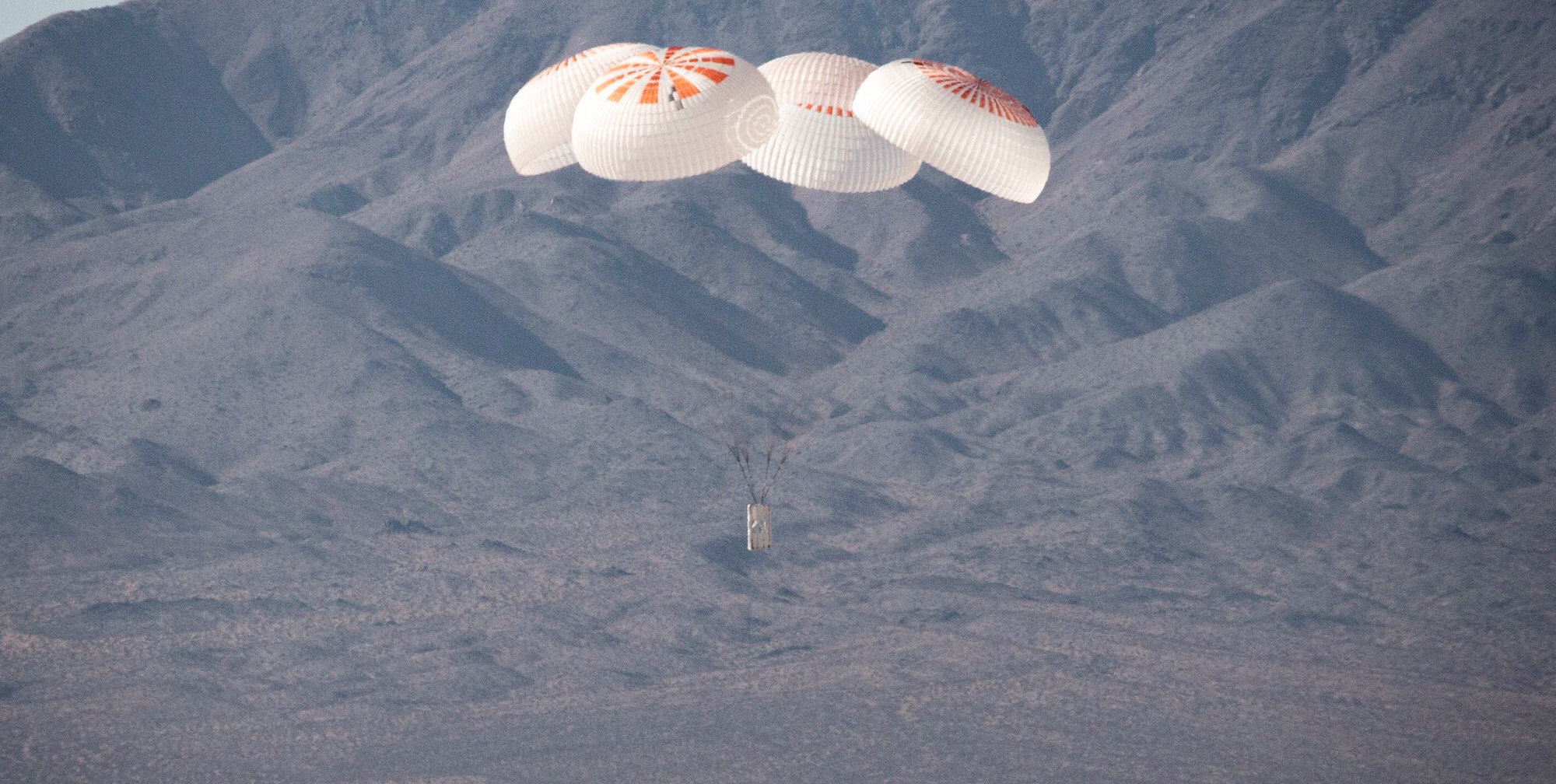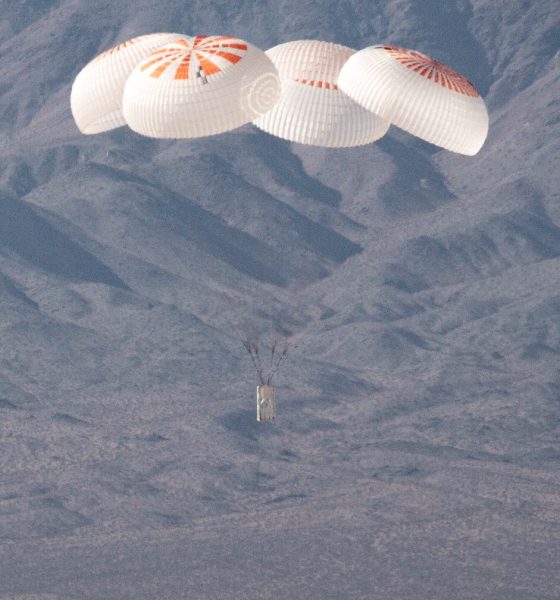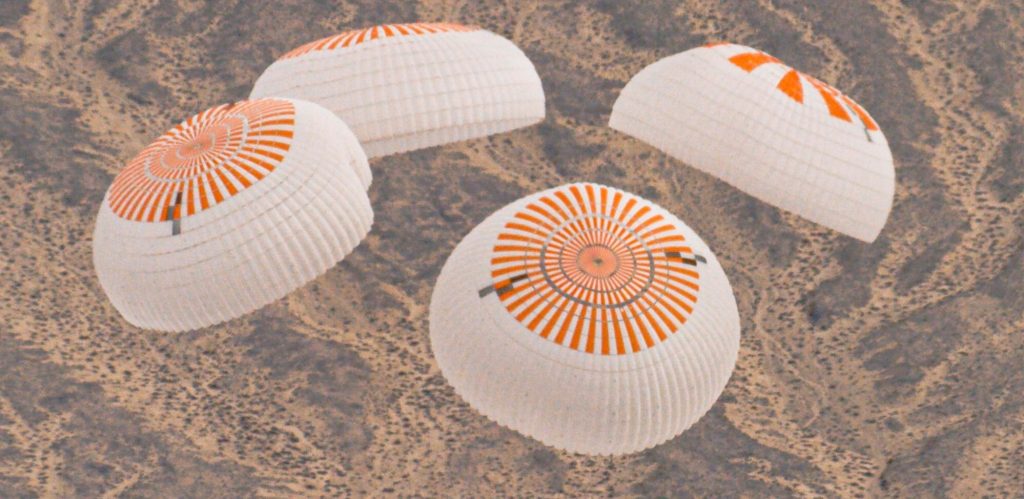

News
SpaceX’s Crew Dragon parachutes are almost ready for NASA astronauts
SpaceX says Crew Dragon’s upgraded “Mk3” parachutes are almost ready to safely return astronauts to Earth and need to pass just a few more consecutive tests before NASA will have the data it needs to qualify them.
Although SpaceX originally hoped to pursue a program of propulsive landing for Crew Dragon and Cargo Dragon space capsules, that effort was canceled to avoid the major cost increases and delays NASA’s qualification certification requirements would have triggered. Already designed with parachutes as a backup, SpaceX quickly pivoted and redesigned those parachutes as the primary (if not sole) method of gently landing astronauts back on Earth.
That decision was likely made in late 2016 or early 2017 and CEO Elon Musk announced the program’s cancellation – as well as plans for “Red Dragon” Mars landings – in July 2017. For the next 18 months, SpaceX worked with suppliers and NASA to design and test a parachute system up to the space agency’s extremely rigid standards. Coincidentally, Cargo Dragon suffered a significant (but survivable) parachute failure the same year when one of its three main chutes failed to deploy before splashdown. Additionally, Crew Dragon’s first “Mk1” parachutes suffered their own failures during testing.
A Mk2 variant was designed and built to account for Mk1’s issues, but it too suffered failures during field tests, particularly struggling to make it through tests simulating the failure of one Dragon’s main parachutes. As a result, NASA further required SpaceX to add a fourth parachute, requiring a whole new round of tests and experimentation due to the significantly different dynamics it introduced. Mk2 testing continued into 2019 but SpaceX quickly switched gears and worked with its supplier to design an even more upgraded “Mk3” parachute, building off of a cutting-edge program to model parachute deployment more accurately than ever before.
Over the course of 2019, SpaceX began to extensively test Mk3 parachutes with a variety of drop tests. Unfortunately, even Mk3 suffered a failure or two at first, leading SpaceX and its supplier to refine the design even further.
“[In October and November,] SpaceX says it successfully completed thirteen consecutive tests of Crew Dragon’s new Mk3 parachutes in less than two weeks. That essentially blew [NASA administrator Jim] Bridenstine’s expectations out of the water, as SpaceX surpassed his predicted 10 tests and did so barely three weeks into the tentative 12-week window he set. SpaceX now has plenty of time to either continue testing Crew Dragon’s parachutes or refocus its efforts on other equally important qualification challenges.
Prior to those thirteen consecutive successes, SpaceX suffered two failures during single-parachute Mk3 testing. The first two development tests of the Mk 3 design used loads much higher than the parachutes would ever see in operation in an effort to better understand overall design margins and system performance. After a period of rapid iteration with parachute provider Airborne Systems, the faults responsible for those two stress-test failures were resolved and subsequent drop tests confirmed that Mk3’s suspension lines – the numerous lines connecting the parachute to Crew Dragon – are far stronger than those on Mk2.”
Teslarati — November 3rd, 2019
In the latest chapter of the Crew Dragon parachute saga, on December 4th, SpaceX tweeted that the spacecraft’s upgraded Mk3 chutes recently completed their seventh successful “system test”. On November 3rd, CEO Elon Musk tweeted that one such multi-chute test had already been completed but said SpaceX wanted to successfully complete ten such consecutive tests before it would feel fully confident in the upgraded parachutes.

If the seven tests SpaceX is now describing are part of the same planned series that kicked off in early November, then those seven were likely consecutive successes and leave just three more tests (give or take) to go. Additional testing may well be required by SpaceX, NASA, or both parties, but if Mk3 continues to perform as well as it has over the last two months, Crew Dragon’s recovery systems ought to be well on their way to NASA certification. Once NASA gives the go-ahead on Crew Dragon’s parachutes (and every other facet of the spacecraft), SpaceX can proceed with its Demo-2 mission, set to be SpaceX’s inaugural astronaut launch and likely to mark the first time the US has launched its own astronauts in nearly nine years.
Check out Teslarati’s Marketplace! We offer Tesla accessories, including for the Tesla Cybertruck and Tesla Model 3.

News
Tesla China delivery centers look packed as 2025 comes to a close
Needless to say, it appears that Tesla China seems intent on ending 2025 on a strong note.

Tesla’s delivery centers in China seem to be absolutely packed as the final days of 2025 wind down, with photos on social media showing delivery locations being filled wall-to-wall with vehicles waiting for their new owners.
Needless to say, it appears that Tesla China seems intent on ending 2025 on a strong note.
Full delivery center hints at year-end demand surge
A recent image from a Chinese delivery center posted by industry watcher @Tslachan on X revealed rows upon rows of freshly prepared Model Y and Model 3 units, some of which were adorned with red bows and teddy bears. Some customers also seem to be looking over their vehicles with Tesla delivery staff.
The images hint at a strong year-end push to clear inventory and deliver as many vehicles as possible. Interestingly enough, several Model Y L vehicles could be seen in the photos, hinting at the demand for the extended wheelbase-six seat variant of the best-selling all-electric crossover.
Strong demand in China
Consumer demand for the Model Y and Model 3 in China seems to be quite notable. This could be inferred from the estimated delivery dates for the Model 3 and Model Y, which have been extended to February 2026 for several variants. Apart from this, the Model Y and Model 3 also continue to rank well in China’s premium EV segment.
From January to November alone, the Model Y took China’s number one spot in the RMB 200,000-RMB 300,000 segment for electric vehicles, selling 359,463 units. The Model 3 sedan took third place, selling 172,392. This is quite impressive considering that both the Model Y and Model 3 are still priced at a premium compared to some of their rivals, such as the Xiaomi SU7 and YU7.
With delivery centers in December being quite busy, it does seem like Tesla China will end the year on a strong note once more.
News
Tesla Giga Berlin draws “red line” over IG Metall union’s 35-hour week demands
Factory manager André Thierig has drawn a “red line” against reducing Giga Berlin’s workweek to 35 hours, while highlighting that Tesla has actually increased its workers’ salaries more substantially than other carmakers in the country.

Tesla Giga Berlin has found itself in a new labor dispute in Germany, where union IG Metall is pushing for adoption of a collective agreement to boost wages and implement changes, such as a 35-hour workweek.
In a comment, Giga Berlin manager André Thierig drew a “red line” against reducing Giga Berlin’s workweek to 35 hours, while highlighting that Tesla has actually increased its workers’ salaries more substantially than other carmakers in the country.
Tesla factory manager’s “red line”
Tesla Germany is expected to hold a works council election in 2026, which André Thierig considers very important. As per the Giga Berlin plant manager, Giga Berlin’s plant expansion plans might be put on hold if the election favors the union. He also spoke against some of the changes that IG Metall is seeking to implement in the factory, like a 35-hour week, as noted in an rbb24 report.
“The discussion about a 35-hour week is a red line for me. We will not cross it,” Theirig said.
“(The election) will determine whether we can continue our successful path in the future in an independent, flexible, and unbureaucratic manner. Personally, I cannot imagine that the decision-makers in the USA will continue to push ahead with the factory expansion if the election results favor IG Metall.”
Giga Berlin’s wage increase
IG Metall district manager Jan Otto told the German news agency DPA that without a collective agreement, Tesla’s wages remain significantly below levels at other German car factories. He noted the company excuses this by referencing its lowest pay grade, but added: “The two lowest pay grades are not even used in car factories.”
In response, Tesla noted that it has raised the wages of Gigafactory Berlin’s workers more than their German competitors. Thierig noted that with a collective agreement, Giga Berlin’s workers would have seen a 2% wage increase this year. But thanks to Tesla not being unionized, Gigafactory Berlin workers were able to receive a 4% increase, as noted in a CarUp report.
“There was a wage increase of 2% this year in the current collective agreement. Because we are in a different economic situation than the industry as a whole, we were able to double the wages – by 4%. Since production started, this corresponds to a wage increase of more than 25% in less than four years,” Thierig stated.
News
Tesla is seeing a lot of momentum from young Koreans in their 20s-30s: report
From January to November, young buyers purchased over 21,000 Teslas, putting it far ahead of fellow imported rivals like BMW and Mercedes-Benz.

Tesla has captured the hearts of South Korea’s 20s-30s demographic, emerging as the group’s top-selling imported car brand in 2025. From January to November, young buyers purchased over 21,000 Teslas, putting it far ahead of fellow imported rivals like BMW and Mercedes-Benz.
Industry experts cited by The Economist attributed this “Tesla frenzy” to fandom culture, where buyers prioritize the brand over traditional car attributes, similar to snapping up the latest iPhone.
Model Y dominates among young buyers
Data from the Korea Imported Automobile Association showed that Tesla sold 21,757 vehicles to the 20s-30s demographic through November, compared to BMW’s 13,666 and Mercedes-Benz’s 6,983. The Model Y led the list overwhelmingly, with variants like the standard and Long Range models topping purchases for both young men and women.
Young men bought around 16,000 Teslas, mostly Model Y (over 15,000 units), followed by Model 3. Young women followed a similar pattern, favoring Model Y (3,888 units) and Model 3 (1,083 units). The Cybertruck saw minimal sales in this group.
The Model Y’s appeal lies in its family-friendly SUV design, 400-500 km range, quick acceleration, and spacious cargo, which is ideal for commuting and leisure. The Model 3, on the other hand, serves as an accessible entry point with lower pricing, which is valuable considering the country’s EV subsidies.
The Tesla boom
Experts described Tesla’s popularity as “fandom culture,” where young buyers embrace the brand despite criticisms from skeptics. Professor Lee Ho-geun called Tesla a “typical early adopter brand,” comparing purchases to iPhones.
Professor Kim Pil-soo noted that young people view Tesla more as a gadget than a car, and they are likely drawn by marketing, subsidies, and perceived value. They also tend to overlook news of numerous recalls, which are mostly over-the-air software updates, and controversies tied to the company.
Tesla’s position as Korea’s top import for 2025 seems secured. As noted by the publication, Tesla’s December sales figures have not been reported yet, but market analysts have suggested that Tesla has all but secured the top spot among the country’s imported cars this year.








